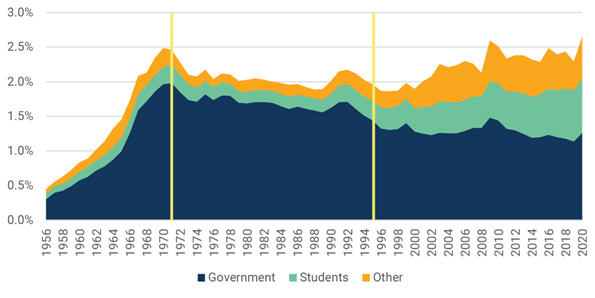The events of the last couple of weeks have kept everyone in the Higher Education sector in a whirlwind. But step back a minute. It’s worth thinking about the big picture.
Some of you may remember this graph which I drew about a year ago, looking at the history of Higher Education funding in Canada. It shows total university and college income by source back to 1955-56. Looking at the trends across these six decades, I think it tells a story of three “eras” or “phases of financing.
Figure 1: Total Income by Source, as a Percentage of Canadian Post-Secondary Institutions, 1955-56 to 2020-21

The First Phase, which began a few years after the second world war, were what might be termed the “Glory Years.” An uninterrupted 12-fold run-up in expenditures which brought Canada to the point where public spending on post-secondary education rose to over 2% of GDP. And this was at a time when the proportion of young people attending university was around a third of what it is now. In that period up to 1971, there was not such thing as “funding formulas;” instead, university Presidents would just walk into Ministers offices and emerge with huge wodges of cash in their pockets. Truly glorious.
The Second Phase was between about 1971 and 1995. This was an era of unabashed decline. Government funding reversed course (as a fraction of the economy) and was not replaced by other forms of income. Part of this was that universities didn’t know how to increase income in other ways, and part of it was that they were simply not allowed to recoup revenue in the form of tuition fees (fee levels declined in real terms in the 70s and then stayed about even during the 1980s). Particularly towards the end of this period, from 1991 to 1994, government cuts made an enormous dent in the sector.
Suddenly, around 1995, things changed. Institutions were allowed to bring more money in from domestic tuition fees, and a lot more money from international students; Ontario deregulated international student fees in 1996, others soon followed suit. Institutions learned to self-generate more non-fee income. And for a few years—from 2000 to 2008—the erosion of government funding stopped and even briefly reversed from 2000 to 2010. When governments then returned to form and allowed funding to stagnate, institutions kept their incomes up by leaning even more heavily (exclusively is probably a better term) on international students.
And then two weeks ago, Marc Miller’s announcement came, which effectively reduced institutional fee income by a substantial—though as of yet still undetermined—amount (I’ll be working on that topic over the next couple of weeks). I think there is a pretty good chance that the Third Phase has has now ended, and we are heading into uncharted territory. I mean, it’s barely conceivable that we could keep the train going on fee income by raising fees to make up for lower numbers, but it’s not clear how many institutions can actually command the kinds of prices that would take (almost none in Ontario but elsewhere I think there may be opportunities). But the likelier path is that we’re heading into a Fourth Phase, a world of declining institutional revenues, just as we were between 1971 and 1995. It’s why everyone in the sector who actually understands what is going on is in shock and mourning, they can see budget cuts to match the loss of income barreling down the track, fast.
We can’t know the exact shape of the Fourth Path, but it’s worth remembering that the years of eroding income during the Second Phase wave were pretty awful. The mid-1990s, for those who don’t remember them, were bad. But there is a path through this. And that is, simply, to be ruthless about efficiency. Lower per-student funding and improved outcomes are not necessarily antithetical. Witness how Université de Montréal manages to produce world-class research outcomes with substantially lower levels of expenditure than the rest of the Big-6. Or, look at how Arizona State University has managed to increase enrolment (especially of underserved minorities) every year for 20 years all the while becoming more research-intensive and dealing with a seemingly never-ending series of cuts in state appropriations (I’ll be coming back to the ASU case on Wednesday, but for now take a look at the 2022 update on ASU’s Strategic Enterprise Plan for some stats).
I’ll be spending a lot of time over the next few months talking about university (and college) transformations, because I think sharing information about this topic is going to be key to getting us all through this Phase. As someone said at last week’s meeting of HESA’s University Vice-Presidents Network: “No single institution created the current funding model, and no single institution is going to create the next one either. We need to co-operate and share information about our initiatives in order to get to a more sustainable model, faster”.
It’s a whole new game now. The faster everyone gets to terms with the rules, the faster we can shape the new system to the benefit of academia and the country.
Let’s get to it.
The post The Dawn of a New Era appeared first on HESA.
#Dawn #Era




More Stories
Four Ways to Create a Supportive and Inclusive Learning Community for Your Students
Higher Ed Officials Express Uncertainty Amid Further FAFSA Delays
Two-thirds of London’s int’l students work during their studies